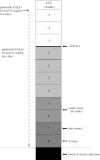Maternal zinc supplementation improves spatial memory in rat pups
- PMID: 22249889
- PMCID: PMC3362702
- DOI: 10.1007/s12011-012-9323-y
Maternal zinc supplementation improves spatial memory in rat pups
Abstract
A large body of evidence supports an opinion that adequate dietary zinc is essential for prenatal and postnatal brain development. Behavioural effects of maternal supplementation with ZnSO(4) were analysed in rat pups with the Morris water task performance, a hole board and a T-maze. Wistar females during pregnancy and lactation received a drinking water solution of ZnSO(4) at doses of 16 mg/kg (group Zn16) or 32 mg/kg (group Zn32). Behavioural tests were conducted on the 4-week-old male rat pups. Zinc concentration in the serum, hippocampus and prefrontal cortex of offsprings was determined by means of atomic absorption techniques. The Newman-Keuls multiple comparison test revealed an increase of climbing in the Zn16 group in comparison to the control group (Con) and the Zn32 group during the hole board test. ANOVA for repeated measures showed a significant memory improvement in both supplemented groups compared to the control in the probe trial on day 5 of the water maze test. ZnSO(4) treatment significantly elevated zinc levels in the rat serum. Follow-up data on brain content of zinc in the hippocampus revealed significant differences between the groups and in supplemented groups correlated with crossings above the original platform position. These findings suggest that pre- and postnatal zinc supplementation may improve cognitive development in rats.
Figures






Similar articles
-
Influence of Long-Term Zinc Administration on Spatial Learning and Exploratory Activity in Rats.Biol Trace Elem Res. 2016 Aug;172(2):408-418. doi: 10.1007/s12011-015-0597-8. Epub 2016 Jan 6. Biol Trace Elem Res. 2016. PMID: 26740219 Free PMC article.
-
Paracetamol - Effect of early exposure on neurotransmission, spatial memory and motor performance in rats.Behav Brain Res. 2017 Apr 14;323:162-171. doi: 10.1016/j.bbr.2017.01.051. Epub 2017 Feb 3. Behav Brain Res. 2017. PMID: 28163096
-
Effects of maternal mild zinc deficiency and zinc supplementation in offspring on spatial memory and hippocampal neuronal ultrastructural changes.Nutrition. 2013 Feb;29(2):457-61. doi: 10.1016/j.nut.2012.09.002. Nutrition. 2013. PMID: 23312766
-
Pharmacological and biochemical effects of Ginkgo biloba extract on learning, memory consolidation and motor activity in old rats.Acta Neurobiol Exp (Wars). 2009;69(2):217-31. doi: 10.55782/ane-2009-1747. Acta Neurobiol Exp (Wars). 2009. PMID: 19593336
-
Effects of an Early Experience Involving Training in a T-Maze Under either Denial or Receipt of Expected Reward through Maternal Contact.Front Endocrinol (Lausanne). 2013 Nov 15;4:178. doi: 10.3389/fendo.2013.00178. Front Endocrinol (Lausanne). 2013. PMID: 24298269 Free PMC article. Review.
Cited by
-
The Important Role of Zinc in Neurological Diseases.Biomolecules. 2022 Dec 23;13(1):28. doi: 10.3390/biom13010028. Biomolecules. 2022. PMID: 36671413 Free PMC article. Review.
-
Zinc Oxide Nanoparticles Attenuated Neurochemical and Histopathological Alterations Associated with Aluminium Chloride Intoxication in Rats.Biol Trace Elem Res. 2025 Apr;203(4):2058-2071. doi: 10.1007/s12011-024-04292-4. Epub 2024 Jul 4. Biol Trace Elem Res. 2025. PMID: 38963645
-
Taurine Increases Zinc Preconditioning-Induced Prevention of Nitrosative Stress, Metabolic Alterations, and Motor Deficits in Young Rats following Intrauterine Ischemia.Oxid Med Cell Longev. 2021 May 6;2021:6696538. doi: 10.1155/2021/6696538. eCollection 2021. Oxid Med Cell Longev. 2021. PMID: 34040692 Free PMC article.
-
High dose zinc supplementation induces hippocampal zinc deficiency and memory impairment with inhibition of BDNF signaling.PLoS One. 2013;8(1):e55384. doi: 10.1371/journal.pone.0055384. Epub 2013 Jan 31. PLoS One. 2013. PMID: 23383172 Free PMC article.
-
Prophylactic Zinc and Therapeutic Selenium Administration Increases the Antioxidant Enzyme Activity in the Rat Temporoparietal Cortex and Improves Memory after a Transient Hypoxia-Ischemia.Oxid Med Cell Longev. 2018 Sep 6;2018:9416432. doi: 10.1155/2018/9416432. eCollection 2018. Oxid Med Cell Longev. 2018. PMID: 30258527 Free PMC article.
References
-
- Halas ES, Wallwork JC, Sandstead HH. Mild zinc deficiency and undernutrition during the prenatal and postnatal periods in rats: effects on weight, food consumption, and brain catecholamine concentrations. J Nutr. 1982;112:542–551. - PubMed
-
- Tomat A, Elesgaray R, Zago V, Fasoli H, Fellet A, Balaszczuk AM, Schreier L, Costa MA, Arranz C. Exposure to zinc deficiency in fetal and postnatal life determines nitric oxide system activity and arterial blood pressure levels in adult rats. Br J Nutr. 2010;104:382–389. doi: 10.1017/S0007114510000759. - DOI - PubMed
MeSH terms
Substances
LinkOut - more resources
Full Text Sources
Medical

